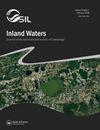筑坝和气候变化对源流生态系统结构的影响——以比利牛斯山脉为例
IF 2.3
3区 环境科学与生态学
Q1 LIMNOLOGY
引用次数: 2
摘要
气候变化、筑坝和金属污染是对水源的主要人为威胁。我们设计了一个案例研究,利用比利牛斯山脉河流的生物膜和大型无脊椎动物群落来评估这些压力因素如何影响源流的生态系统结构。我们观察到溪流中强烈的季节性模式与分析的压力源相互作用,对生态系统结构参数有协同作用,但也有拮抗作用。筑坝和降水减少都减少了河流的流量,并提高了河流的温度,这促进了藻类和大型无脊椎动物生物量的增加,但却牺牲了它们群落的生物多样性,这种情况在气候变化的背景下预计会恶化。降水的减少也增加了水柱和生物膜中金属和类金属的浓度,但筑坝引水减少了它们对下游的贡献。在当前气候变化的背景下,鼓励在水坝蓄水的河流中保持足够的生态流量,以克服这些影响。需要更多的实地研究来评估多种人为压力源如何在现实和应用的背景下相互作用并威胁生态系统的完整性。本文章由计算机程序翻译,如有差异,请以英文原文为准。
Impacts of damming and climate change on the ecosystem structure of headwater streams: a case study from the Pyrenees
ABSTRACT Climate change, damming, and metal pollution are among the main anthropogenic threats to headwater streams. We designed a case study to assess how these stressors impact the ecosystem structure of headwater streams by using the biofilm and macroinvertebrate communities of a Pyrenean stream. We observed a strong seasonal pattern in the stream that interacted with the analysed stressors by having synergistic, but also antagonistic, responses on the ecosystem structural parameters. Both damming and a decrease in precipitation reduced the water flow of the stream and increased its temperature, which promoted an increase in algal and macroinvertebrate biomass at the expense of the biodiversity of their communities, a situation expected to worsen in a climate change context. The decrease in precipitation also increased the concentration of metals and metalloids in the water column and in biofilms, but the water diversion from damming reduced their contributions downstream. The maintenance of an adequate ecological flow in dam-impounded streams is encouraged to overcome these impacts in the current climate change context. More field studies are needed to assess how multiple anthropogenic stressors interact and threaten the ecosystem integrity in a realistic and applied context.
求助全文
通过发布文献求助,成功后即可免费获取论文全文。
去求助
来源期刊

Inland Waters
LIMNOLOGY-MARINE & FRESHWATER BIOLOGY
CiteScore
6.10
自引率
9.70%
发文量
34
审稿时长
>12 weeks
期刊介绍:
Inland Waters is the peer-reviewed, scholarly outlet for original papers that advance science within the framework of the International Society of Limnology (SIL). The journal promotes understanding of inland aquatic ecosystems and their management. Subject matter parallels the content of SIL Congresses, and submissions based on presentations are encouraged.
All aspects of physical, chemical, and biological limnology are appropriate, as are papers on applied and regional limnology. The journal also aims to publish articles resulting from plenary lectures presented at SIL Congresses and occasional synthesis articles, as well as issues dedicated to a particular theme, specific water body, or aquatic ecosystem in a geographical area. Publication in the journal is not restricted to SIL members.
 求助内容:
求助内容: 应助结果提醒方式:
应助结果提醒方式:


